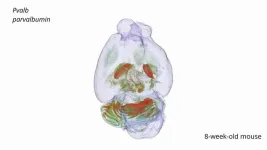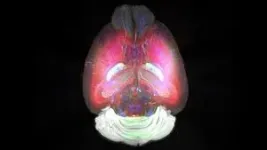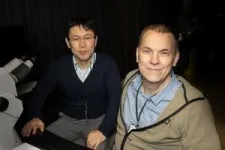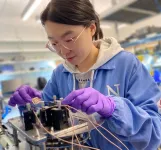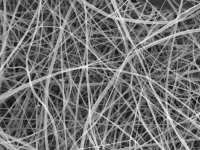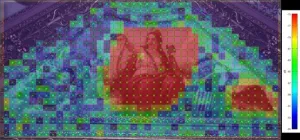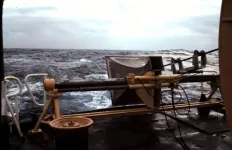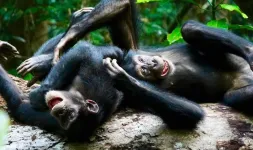(Press-News.org) Researchers at Karolinska Institutet and Karolinska University Hospital have developed a groundbreaking microscopy method that enables detailed three-dimensional (3D) RNA analysis at cellular resolution in whole intact mouse brains. The new method, called TRISCO, has the potential to transform our understanding of brain function, both in normal conditions and in disease, according to the new study published in Science.
Despite great advances in RNA analysis, linking RNA data to its spatial context has long been a challenge, especially in intact 3D tissue volumes. The TRISCO method now makes it possible to perform three-dimensional RNA imaging of whole mouse brains without the need to slice the brain into thin sections, which was previously necessary.
“This method is a powerful tool that can drive brain research forward. With TRISCO, we can study the complex anatomical structure of the brain in a way that was previously not possible,” says Per Uhlén, professor at the Department of Medical Biochemistry and Biophysics, Karolinska Institutet, and the study's last author.
In the study, up to three different RNA molecules were analysed simultaneously. The next step for the researchers is to expand the number of RNA molecules that can be studied to around a hundred, using a technique called multiplex RNA analysis. This could provide even more detailed information about brain function and disease states.
The TRISCO approach opens up new possibilities to understand the complexity of the brain in depth, which in turn can lead to the development of new treatments for various brain diseases.
“We look forward to continuing our research and exploring the many possibilities offered by this new technique,” says Shigeaki Kanatani, a research specialist in Uhlén’s laboratory and the first author of the study.
Not only is TRISCO suitable for studying intact mouse brains, but the study demonstrates it can be used for larger brains, such as those of guinea pigs, and various tissues like kidney, heart, and lung. The study is a collaboration between Karolinska Institutet and Karolinska University Hospital.
“Our laboratory has several collaborations with clinically active researchers at Karolinska University Hospital. It is crucial for biomedical research that basic researchers and clinicians collaborate and understand each other,” says Per Uhlén.
The study has been funded by the Swedish Research Council, Swedish Brain Foundation and Swedish Cancer Society. Some of the co-authors are employed and own shares in the Danish company Gubra. No other conflicts of interest are reported.
Publication: ‘Whole-Brain Spatial Transcriptional Analysis at Cellular Resolution’, Shigeaki Kanatani, Judith C. Kreutzmann, Yue Li, Zoe West, Lea Lydolph Larsen, Danai Vougesi Nikou, Ilse Eidhof, Abigail Walton, Songbai Zhang, Leslie Rubio Rodríguez-Kirby, Jacob Lercke Skytte, Casper Gravesen Salinas, Kimiharu Takamatsu, Xiaofei Li, Daisuke H. Tanaka, Dagmara Kaczynska, Keishiro Fukumoto, Razieh Karamzadeh, Yujiao Xiang, Naofumi Uesaka, Tsutomu Tanabe, Mikael Adner, Johan Hartman, Ayako Miyakawa, Erik Sundström, Gonçalo Castelo-Branco, Urmas Roostalu, Jacob Hecksher-Sørensen, Per Uhlén, Science, online 22 November 2024, doi: 10.1126/science.adn9947
END
New imaging method enables detailed RNA analysis of the whole brain
2024-11-21
ELSE PRESS RELEASES FROM THIS DATE:
Stability of perovskite solar cells doubled with protective coating
2024-11-21
Northwestern University scientists have developed a new protective coating that significantly extends the life of perovskite solar cells, making them more practical for applications outside the lab.
Although perovskite solar cells are more efficient and less expensive than traditional silicon solar cells, perovskite has, until now, been limited by its lack of long-term stability. Typically, perovskite solar cells uses an ammonium-based coating layer to enhance efficiency. While effective, ammonium-based layers degrade under environmental stress, such as heat and moisure.
Northwestern ...
Chemists create world’s thinnest spaghetti
2024-11-21
The world’s thinnest spaghetti, about 200 times thinner than a human hair, has been created by a UCL-led research team.
The spaghetti is not intended to be a new food but was created because of the wide-ranging uses that extremely thin strands of material, called nanofibers, have in medicine and industry.
Nanofibers made of starch – produced by most green plants to store excess glucose – are especially promising and could be used in bandages to aid wound healing (as the nanofiber mats are highly porous, allowing water and moisture in but keeping ...
Empowering neuroscience: Large open brain models released
2024-11-21
The hippocampus is one of the most fascinating brain regions. Associated with the formation of memories, it also helps us to navigate through the world without getting lost. Sensory cortices on the other hand play an important role in how we perceive our environment and make appropriate movements, and how our brains determine what to focus on and what to ignore. While both regions have been extensively studied and many of their secrets revealed, there is still a lot we do not understand about them due to the high complexity of ...
From traditional to technological: Advancements in fresco conservation
2024-11-21
MELVILLE, N.Y., Nov. 21, 2024 – Fresco painting, a technique that dates back to antiquity, involves applying dry pigments to wet plaster, creating stunning artwork that can last for centuries. Over time, however, these masterpieces often face degradation due to delamination, where decorative plaster layers separate from the underlying masonry or structural plaster. This deterioration can compromise the structural integrity of the artwork, necessitating restoration efforts.
Historically, conservators have gently knocked on the plaster with their knuckles or small mallets to assess the condition of the fresco. By listening to the emitted sound, they could identify the delaminated areas ...
Design and imagination as essential tools during the climate crisis
2024-11-21
In Nature Partner Journals, ten researchers advocate the use of imagination in tackling the climate crisis. They focus specifically on urbanising river deltas, which are of great social and economic importance and highly vulnerable to climate change. "We scientists should not merely outline doomsday scenarios," says Professor Chris Zevenbergen. "Create a vision for people to believe in and work towards.”
From doomscenarios to desired outcomes
Due to the climate crisis, urban river deltas ...
Innovating archaeology: HKU scholars utilize immersive 3D tech to document and study the human past
2024-11-21
Archaeologists from the Faculty of Arts at the University of Hong Kong (HKU) are revolutionising the excavation and documentation of ancient sites with cutting-edge 3D immersive technologies.
Archaeology studies the human past through the excavation of things people made and used thousands of years ago – from architecture to objects like pottery bowls and animal bones from meals. Although many excavation projects create digital 3D models of what they uncover, archaeologists need new ways to meaningfully use those data. Some projects share 3D models with the public as tourism and teaching tools – ...
What's the story, morning glory?
2024-11-21
Photos
Morning glory plants that can resist the effects of glyphosate also resist damage from herbivorous insects, according to a University of Michigan study.
The U-M researchers also found the reverse: plants treated with and susceptible to glyphosate, the active ingredient in the herbicide RoundUp, are also susceptible to damage from insects. This suggests that glyphosate, a herbicide humans have introduced into the environment, can disrupt the co-evolution of plants and their insect herbivores. ...
The unsolved mystery sounds of the Southern Ocean #ASA187
2024-11-21
MELVILLE, N.Y., Nov. 21, 2024 – Mysterious, repeating sounds from the depths of the ocean can be terrifying to some, but in the 1980s, they presented a unique look at an underwater soundscape.
In July 1982, researchers in New Zealand recorded unidentifiable sounds as a part of an experiment to characterize the soundscape of the South Fiji Basin. The sound consisted of four short bursts resembling a quack, which inspired the name of the sound “Bio-Duck.”
“The sound was so repeatable, we couldn’t believe at first that it was biological,” said ...
These wild chimpanzees play as adults to better cooperate as a group
2024-11-21
Compared to children, adults don’t play as much, but social play into adulthood is considered a universal human trait. Play has a role in building tolerance, cohesion, bonding, and cooperation. By comparison, play in adults of other species has been considered rare, and yet a new study reported in the Cell Press journal Current Biology on November 21 shows that some chimpanzees, like people, continue to play often throughout their entire lives and especially before engaging in acts that require collective cooperation.
“We show that adult social play in chimpanzees can foster a range of cooperative behaviors, from dyadic interactions to complex, risky ...
Physical activity and all-cause mortality by age in 4 multinational megacohorts
2024-11-21
About The Study: In this pooled analysis of cohort studies, the association between physical activity and mortality risk remained consistent across the adult lifespan, which contrasts with other modifiable health factors, for which associations with mortality risk diminished with age. Given these findings, the promotion of regular physical activity is essential at all stages of adult life.
Corresponding Author: To contact the corresponding author, David Martinez-Gomez, PhD, email d.martinez@uam.es.
To ...
